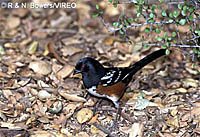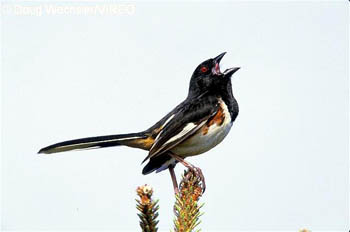Loading ...
Eastern Towhee
The Eastern Towhee (Pipilo erythrophthalmus), was formerly lumped with the western Spotted Towhee as one species -- "Rufous-sided Towhee." It is a strikingly handsome ground forager with a black hood, breast and back, rufous flanks and a long black tail spotted with white at the corners. The Eastern Towhee is a year-round resident in the southern half of the eastern U.S. from Virginia and Illinois south through the Florida peninsula, a breeding bird north to the Canadian border (excluding Maine), and in the mild winters of recent years, a wintering bird north to the southern Great Lakes. The name Towhee was chosen by colonial-era naturalist Mark Catesby based on one of the bird's calls, but this vocal bird is better known for its crisp "chewink" and its memorable, quavering "drink-your-teeeee" or just "your-teeeee".
See all Eastern Towhee photosField Marks:
The Eastern Towhee has a black hood (brown in the females), rufous flanks, white belly, and a white crescent in the outer wing primaries. It obtained its scientific species name (erythrophthalmus) from its prominent red eyes; however, the southern subspecies of the Eastern Towhee has pale eyes. (L. 8.5 in.)
Distribution:
The Eastern Towhee is a permanent resident ranging from Virginia south through the Florida peninsula and a wintering bird in mild winters north to the southern Great Lakes. The bird breeds north to Canada, excluding Maine.
Similar Species:
 |
Spotted Towhee (species account) Spotted Towhee has varying amounts of white flecking on its back and two white wing bars. It lives in the Western U.S. and adjacent part of Canada. |
Habitat & Nesting:
The Eastern Towhee nests mostly on the ground in dense deciduous thickets. Towhee populations, especially in the Northeast, have declined significantly since 1966, probably because of the combined impacts of habitat loss through urbanization and nest predation from cats and raccoons.
More Information:
The Eastern Towhee has a distinctive habit of exposing insect and vegetable food hidden under leaf litter on the ground by using a two-stroke, forward-and-back, hop-and-scratch movement with both feet. The Eastern Towhee interbreeds with the Spotted Towhee, and the species classification is perennially debated.

